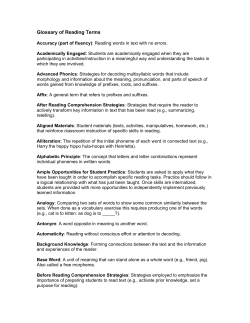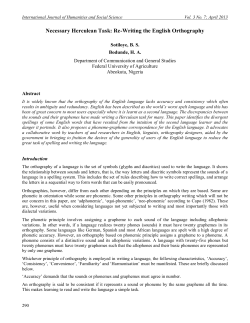
Document 25917
At Chevening Primary School phonics is carefully planned and assessed using the recommended Government programme, ‘Letters and Sounds’. Every child’s progress is tracked and monitored to ensure learning is focused and correctly matched to their needs. Through short, sharp sessions the children have great fun learning effective strategies to help them read and spell words. The information that follows is designed to provide you with a clearer understanding of phonics, helping you to support your child through using the same terminology and methods used at school. Glossary Phoneme - The smallest unit of sound. There are approximately 44 phonemes in English (it does depend on different accents). Phonemes can be put together to make words. They are referred to at Chevening as sounds. Use the phoneme checker on the following website to listen to the correct pronunciation of each. http://www.kenttrustweb.org.uk/kentict/content/games/phonemeChecker.html Grapheme - A way of writing down a phoneme. Graphemes can be made up from 1 letter e.g. p, 2 letters e.g. sh, 3 letters e.g. igh or 4 letters e.g ough. GPC - This is short for Grapheme Phoneme Correspondence. Knowing a GPC means being able to match a sound to the correct letters and vice versa. Digraph - A grapheme containing two letters that makes just one sound (phoneme). Trigraph - A grapheme containing three letters that makes just one sound (phoneme). Oral Blending - This involves hearing phonemes and being able to merge them together to make a word. Children need to develop this skill before they will be able to blend written words. Blending- This involves looking at a written word, looking at each grapheme and using knowledge of GPCs to work out which phoneme each grapheme represents and then merging these phonemes together to make a word. This is the basis of reading. Oral Segmenting - This is the process of hearing a whole word and then splitting it up into the phonemes that make it. Children need to develop this skill before they will be able to segment words to spell them. Segmenting - This involves hearing a word, splitting it up into the phonemes that make it, using knowledge of GPCs to work out which graphemes represent those phonemes and then writing those graphemes down in the right order. This is the basis of spelling. Phase 1 - Subject Knowledge There are approximately 44 phonemes in English Phase 1 is absolutely vital. It is the one phase that shouldn't come to an end. These skills should continue to be developed throughout KS1 and KS2. Phase 1 develops children’s abilities to listen to, make, explore and talk about sounds. Phase 4 - Subject Knowledge The main challenge in this phase is to help children to blend and segment words with adjacent consonants e.g. truck, help. In these words both consonants can be heard when you say the word aloud, making them different from a digraph where there are two letters that make just one sound. Phase 2 - Subject Knowledge GPCs need to be introduced in systematic way. Set 1 - s a t p Set 2 - i n m d Set 3 - g o c k Set 4 - ck e u r Set 5 - h b f ff l ll s ss It is very important that you pronounce these phonemes clearly and correctly using a pure sound. If you don't, children will find it very difficult to blend them together. (See website above) When introducing GPCs, ensure you introduce them with the sounds, pictures, and lots of practise of forming the letter. You can form the letter with a finger in the air, on the palm of the hand, on the back of another child, on a rough surface like the floor. All these experiences will need to come before trying to write the letter on a whiteboard or piece of paper. Phase 5a (Weeks 1-4) - Subject Knowledge New GPCs are introduced in the same way as in previous phases. Five of these GPCs are known as split digraphs. They are a_e, e_e, i_e, o_e, u_e. These used to be taught as magic e but now it is recommended that children learn to recognise these in the same way as other graphemes by simply explaining that in these particular graphemes the two letters work as a team although they aren't directly next to each other. We imagine a link between the two letters that joins them underneath and use our finger to trace it. Phase 3 - Subject Knowledge Phase 3 continues in the same way as Phase 2 and introduces more GPCs. By the end of Phase 3 the children will know one way of writing down each of the 44 phonemes. Set 6 - j v w x Set 7 - y z zz qu Consonant digraphs - ch sh th ng Vowel digraphs (and trigraphs) ai ee igh oa oo ar or ur ow oi ear air ure er The children continue to make CVC words. A CVC word is a word with a consonant phoneme, a vowel phoneme and then a consonant phoneme - it is not referring to letters. Therefore hot, bed, boat and ship are all CVC words but cow and toy are not. Phase 5b (Weeks 4-7) - Subject Knowledge These 3 weeks introduce the idea that some graphemes can be pronounced in more than one way. E.g. the ‘ch’ can be pronounced in each of these ways ‘check’, ‘chef’ and ‘school’. This is a vital lesson for children to learn and they need to learn to apply it in their reading. It is modeled by trying to read a word by sounding out the most obvious phonemes then blending it together before trying an alternative pronunciation. The children learn the best bet and therefore the most common spelling pattern. Phase 5c (Weeks 8-30) This part of Phase 5 is all about learning that some phonemes have more than one spelling. Phase 6 - Subject Knowledge Phase 6 reinforces much of the learning from Phase 5, helps children to develop greater automaticity in reading and begins to explore spelling rules and conventions e.g. adding ing and -ed. Teaching methods Blending words for reading Children draw sound buttons underneath the words helping them to focus on the individual sounds in a word. If it is a single letter phoneme a dot is drawn under. However if two or more letters are used then a line is used. For example Cat: all three sounds would have a dot drawn beneath them. Fish: the f and i would have a dot drawn underneath and sh would be underlined. Church :all three sounds would be underlined Cake: dot is drawn underneath c and k but a link is made between the letters a and e. The children are taught to link the split letters before dropping down to the letter in the middle, in a sweeping action. Segmenting words for spelling When writing an unfamiliar word children are encouraged to take a deep breath and puff out the sounds they hear in the word they want to use. The children say the word very slowly and as each sound is released a thumb or finger is raised. The children then repeat the word and check they have got every sound they can hear. The children then strike across their fingers saying the original word quickly. They then write down the corresponding letter shapes, repeating the puffing process if forgotten. Recommended websites Phonics Play http://www.phonicsplay.co.uk/ This is a very popular website used in class due to its fun and cheeky games that match Letters and Sounds. It also has printable resources. Ictgames www.ictgames.com/literacy.html This has a great selection of games that link well with Letters and Sounds. Oxford owl www.oxfordowl.co.uk A very useful website for parents and teachers. It contains up to 250 free e-books and fun games and activities for the children to play. Roy the Zebra http://www.roythezebra.com/ A fantastic website with lots of fun games for all stages of phonics (some are only for paying subscribers). Words and Pictures http://www.bbc.co.uk/schools/wordsandpictures/index.shtml A clearly set out and easy to use website, well worth a look. Northwood Phonics http://www.northwood.org.uk/phonics Some different games that we don’t play in school, but could be fun on a one to one basis.
© Copyright 2025





















